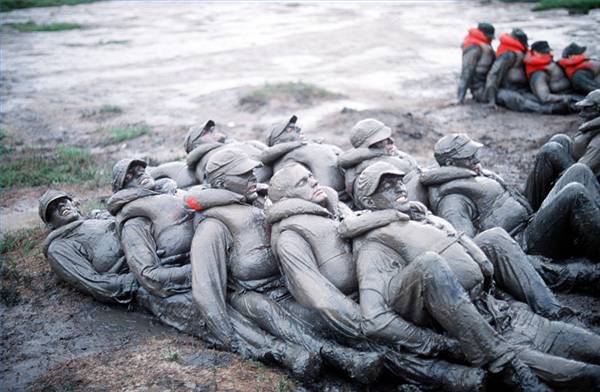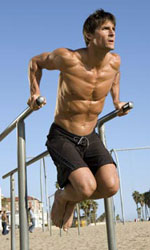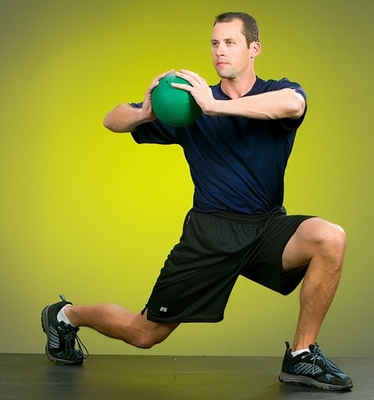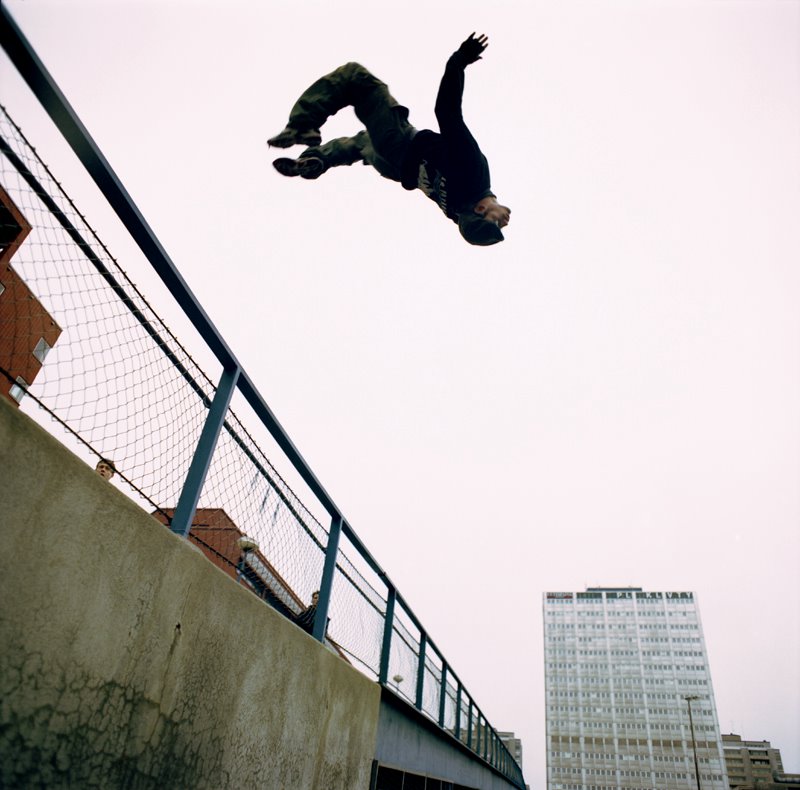 It all started when my Dad bought me the Marine Corps 3X Fitness Program for my 11th birthday. This book taught me how to do pushups, pullups, and situps like the Marines, and I was ecstatic about it. More importantly though, it piqued an interest about getting stronger, and being all that I could be. Soon after, I also got a weight set – you know, the ones with the plastic plates. I did nothing but the essentials: bench press, bicep curls, and some “other stuff.” Along with my 100 lb Everlast punching bag, I was in adolescent paradise down in my training lair under my parents house. That was all the way back in middle school…
It all started when my Dad bought me the Marine Corps 3X Fitness Program for my 11th birthday. This book taught me how to do pushups, pullups, and situps like the Marines, and I was ecstatic about it. More importantly though, it piqued an interest about getting stronger, and being all that I could be. Soon after, I also got a weight set – you know, the ones with the plastic plates. I did nothing but the essentials: bench press, bicep curls, and some “other stuff.” Along with my 100 lb Everlast punching bag, I was in adolescent paradise down in my training lair under my parents house. That was all the way back in middle school…
 In high school, my training took a significant leap forward. Being a cadet in the United States Naval Sea Cadet Corps, and planning on a career in the Navy, with the hopes of pursuing SEAL training, I picked up a copy of Stew Smith’s Maximum Fitness – a cross training manual for Navy SEAL/S. I got ripped my freshman year of high school. I was a legit “freak.” I set some PR’s like 110 pushups in two minutes, 30 deadhang pullups, 220 situps in 2 minutes, etc. I could run forever, and I ran the fastest mile out of over 240 recruits in boots and combat gear – winning my company “charlie” some essential points. At bootcamp, the Commanding Officer presiding over the entire East Coast division complimented me during the Charlie Company inspection. After looking at my name tag, he mused, “Sifferman, huh? I’ve heard that name before. They say you went up the climbing rope like a monkey at the o-course. Keep it up, son.” Was I proud? Yes. Was I cocky? Oh yeah.
In high school, my training took a significant leap forward. Being a cadet in the United States Naval Sea Cadet Corps, and planning on a career in the Navy, with the hopes of pursuing SEAL training, I picked up a copy of Stew Smith’s Maximum Fitness – a cross training manual for Navy SEAL/S. I got ripped my freshman year of high school. I was a legit “freak.” I set some PR’s like 110 pushups in two minutes, 30 deadhang pullups, 220 situps in 2 minutes, etc. I could run forever, and I ran the fastest mile out of over 240 recruits in boots and combat gear – winning my company “charlie” some essential points. At bootcamp, the Commanding Officer presiding over the entire East Coast division complimented me during the Charlie Company inspection. After looking at my name tag, he mused, “Sifferman, huh? I’ve heard that name before. They say you went up the climbing rope like a monkey at the o-course. Keep it up, son.” Was I proud? Yes. Was I cocky? Oh yeah.
I also did sports in high school. It was cross country running in the fall, winter track, and spring track and field. I took summers mostly off, but I still ran off and on, especially leading up to the Fall. I ran so hard those seasons that I developed some major injuries in my legs from overtraining, which ultimately resulted in 3 years of physical therapy to rehabilitate me (but that’s another story). My career as a Navy SEAL was no longer plausible, so I fell back to “normal fitness training.” This is when things got interesting.
After high school, I began trying a LOT of different training styles. I simply couldn’t find anything that suited me perfectly.
 One of my first focused training programs was with a training partner that was into bodybuilding. Ethan was much bigger than me, and always outperformed me a little bit on each lift (except the bench press, he had a huge advantage on that one). He would get program ideas from bodybuilding magazines, and enjoy making girls wince at the pictures inside. I spent almost 9 months in that bodybuilding-style routine. It was a classic split routine, body part specific, and I gained almost 20 lbs. By the end, I could crank out 50 parallel bar dips (full range of motion, not those sissy dips I see at the gym all the time), and 30 deadhang pullups. All of my lifts were going up consistently. I was definitely bigger and turned some heads in the gym, especially around repetition 40 on those dips! I had what most guys wanted in a physique, but I didn’t feel good. I felt strong in the gym, weak everywhere else. I couldn’t move as well as I used to. I even had trouble scratching my back, cliche, I know. Ultimately, I decided that bodybuilding-style training wasn’t for me – but what was? My search continued.
One of my first focused training programs was with a training partner that was into bodybuilding. Ethan was much bigger than me, and always outperformed me a little bit on each lift (except the bench press, he had a huge advantage on that one). He would get program ideas from bodybuilding magazines, and enjoy making girls wince at the pictures inside. I spent almost 9 months in that bodybuilding-style routine. It was a classic split routine, body part specific, and I gained almost 20 lbs. By the end, I could crank out 50 parallel bar dips (full range of motion, not those sissy dips I see at the gym all the time), and 30 deadhang pullups. All of my lifts were going up consistently. I was definitely bigger and turned some heads in the gym, especially around repetition 40 on those dips! I had what most guys wanted in a physique, but I didn’t feel good. I felt strong in the gym, weak everywhere else. I couldn’t move as well as I used to. I even had trouble scratching my back, cliche, I know. Ultimately, I decided that bodybuilding-style training wasn’t for me – but what was? My search continued.

 This is when my training got a little bit hazy. It wasn’t focused anymore, there was too much to do, too many new things to try, and I got lost for awhile. Sure, I had some focused training cycles like improving my clean and jerk, and my deadlift, but my training was scattered at best. On top of my training, and full time college, I had also started a sole proprietorship landscaping company. I also got my National Strength and Conditioning Association personal trainer certification around this time, and began working at a local health club as a one-on-one personal trainer. I was getting burnt out, and it finally had to happen.
This is when my training got a little bit hazy. It wasn’t focused anymore, there was too much to do, too many new things to try, and I got lost for awhile. Sure, I had some focused training cycles like improving my clean and jerk, and my deadlift, but my training was scattered at best. On top of my training, and full time college, I had also started a sole proprietorship landscaping company. I also got my National Strength and Conditioning Association personal trainer certification around this time, and began working at a local health club as a one-on-one personal trainer. I was getting burnt out, and it finally had to happen.
During a deadlifting micro-cycle, I was building up my volume, doing 225 for high reps. In the middle of a set, a disk in my lumbar spine slipped, and I immediately dropped the barbell and fell to the floor. I could lament over the details, but the takehome point is that this event initiated a major change in me. I re-examined why I was lifting weights. I clearly outlined my goals and priorities and realized that I didn’t need to lift very heavy weights to achieve my strength goals. I recognized that I don’t have to be the strongest, only strong enough. I realized that I have never in my life encountered something that I was not physically strong enough to overcome – and yet I had still been pursuing more strength.
I consider this event similar to a new birth, a completely new life and new way of thinking about health, fitness, and strength training. I began to focus on what I call “real world strength,” and putting health at the top of my physical priorities. It was two years before I was no longer in daily pain (I would go to bed in pain, and wake up in even greater pain.). Not having health insurance this time through, I had to search out my own answers, and that’s what led me to a better understanding of balancing hard and soft styles of training. This is what ultimately led me to the Circular Strength Training system (CST), which is the next logical step in my lifelong evolution. I’ve been practicing elements of CST for the past 3 years, and will be attending their certification seminar this August to get certified as an instructor.
But I wouldn’t say it will end here. I don’t think Circular Strength Training is the end-all, be-all. Sure, I think it is the most comprehensive system I have ever experienced for attaining specific goals with longevity and health in mind – but it isn’t complete, at least not yet. The CST tribe is all about constant evolution, and bringing new experiences into their community to seek excellence together. When I share the CST ranks, I’ll blend my experiences with theirs and we will all be better for it.
 Where will this evolution take me down the road? Who knows. But then again, I’m also hearing more and more about primal fitness systems that really get back to our roots. Things like parkour, freerunning, and most recently MovNat by Erwan Le Corre (based on Georges Hebert’s Le Methode Naturelle… Erwan’s awesome promo video is here).
Where will this evolution take me down the road? Who knows. But then again, I’m also hearing more and more about primal fitness systems that really get back to our roots. Things like parkour, freerunning, and most recently MovNat by Erwan Le Corre (based on Georges Hebert’s Le Methode Naturelle… Erwan’s awesome promo video is here).
Regardless, I’m taking the next step – diving head-first into what I know is the best route for me right now, and CST seems to be the hidden treasure that I’ve been looking for. Find more information about CST at the official site here:
To your health and success,
.jpg)
![]()
Fitness Professional and CST Athlete


Hi John, great story and interesting journey.
Could you expand on what you mean when you say that CST “isn’t complete”. What do you think would be a ‘complete’ system? Do you think there is such a thing? I don’t think so myself, because no system can prepare you for all outcomes. The founder of CST developed the system as a strength and conditioning system for combat sport, so its probably fair to say its pretty complete as a system to achieve that, but if improving your combat fitness isn’t your objective then perhaps there will be gaps in it. Depends on your goals really.
I think the big question for all of us is what are our goals, and the even bigger question is why do we think we want to achieve them? For what are we getting fit???…
Hi Nick,
Those are good questions, and ones that each of us should answer before we embark on any fitness journey.
In my experience with CST, it is constantly evolving – and just that alone means it is not complete. Nor do I think any fitness system could ever be totally complete (but I think CST comes about as close as it gets – not only for combat sports, but most other activities too).
And you’re right, it’s theoretically impossible for any one training system to prepare a person for all outcomes, the elusive unknown circumstances. This is not to say that a training system cannot prepare someone for most of life’s situations, only that this question has so many subjective factors, which makes it impossible to answer with absolute certainty. It’s simply too broad a question. Like I mentioned above, I’ve never been the strongest, but I’ve always been strong enough for the tasks that my life has required of me. I’ve never encountered a situation that I couldn’t physically handle, and I think my training has had a major influence on that – even if I wasn’t training specifically for fighting, or lifting, etc.
Although, I have been reading a lot about fitness systems being created to prepare people for the “unknown.” CrossFit says that this is what they do – which isn’t really true when the rubber meets the road (but it’s a nice theoretical training philosophy). More recently, I’ve read about MovNat, which also claims to prepare the trainee for anything that life throws at them – training that spans across all major physical skills (walking, sprinting, carrying, climbing, self defense, etc.).
Answering this question is way beyond my expertise, but I’m happy to discuss it with others here.
Is it possible to train for the unknown – to train for everything that could possibly happen? What are the benefits and drawbacks of this type of generalized training?
Hi John,
I’m an 18 year old high school senior trying to lose weight and get in much better shape. I’m a football lineman, so I’m strong, but I’m really heavy and get gassed running over 100 yards. I picked up Maximum Fitness at a garage sale and your description of becoming a PT “freak” really interests me. What cycles from the book did you do? Do you think it’s a good way to get in that kind of shape? I’m 6’6 280 pounds and my goal is to get leaner and into incredible shape like you did. Any help would be appreciated.
Hey Mike, I started at the beginning of the book and worked my way through to the end. I’d recommend you do the same. -John